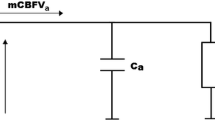Summary
A mathematical model is described that demonstrated the properties of cerebral vascular resistance and compliance expressed as a function of cerebral perfusion pressure (CPP) and arterial CO2 partial pressure (PaCO2). The hypercapnic induced shift of the lower limit of autoregulation to a higher range of CPP, as shown by this model, is a useful characteristic that facilitates the differentiation between normal and impaired autoregulation described previously in experimental studies. Dynamic properties of cerebrovascular circulation derived from the relationship between pulse wave of CBF waveform and CPP have been analysed at different levels of PaCO2-phenomenon, being often described as dependence of blood flow velocity pulsatility index on the autoregulatory reserve. The model was also used to interpret interhemispheric asymmetry of CBF reactivity to changes in arterial concentration of CO2 in patients with carotid artery stenosis.
Similar content being viewed by others
References
Aaslid R, Lindegaard KF, Sorteberg Wet al (1989) Cerebral autoregulation dynamics in human. Stroke 20: 45–52
Bullock R, Mendelow AD, Bone Iet al (1985) Cerebral blood flow and CO2 responsiveness as an indicator of collateral reserve capacity in patients with carotid arterial disease. Br J Surg 72: 348–351
Chan KH, Miller DJ, Dearden Met al (1992) The effect of changes in cerebral perfusion pressure upon middle cerebral artery blood flow velocity and jugular bulb venous oxygen saturation after severe brain trauma. J Neurosurg 77: 55–61
Czosnyka M, Pickard JD, Whitehouse Het al (1992) The hyperaemic response to a transient reduction in cerebral perfusion pressure. A modelling study. Acta Neurochir (Wien) 115: 90–97
Czosnyka M, Koszewski W, Laniewski Pet al (1992) The dynamics of cerebral blood flow, perfusion pressure and CSF circulation — a modelling study. In: Intracranial pressure VIII. Springer, Berlin Heidelberg New York (in press)
Florence G, Seylaz J (1992) Rapid autoregulation of cerebral blood flow: a laser-Doppler flowmetry study. J Cereb Blood Flow Metab 12: 674–680
Giller CA (1991) The frequency dependent behaviour of cerebral autoregulation. Neurosurgery 27: 362–367
Giller CA (1991) A bedside test for cerebral autoregulation using transcranial Doppler ultrasound. Acta Neurochir (Wien) 108: 7–14
Giulioni M, Ursino M, Alvisi C (1988) Correlations among intracranial pulsatility, intracranial hemodynamics, and transcranial Doppler waveform: literature review and hypothesis for future studies. Neurosurgery 22: 807–812
Harper M, Glass HI (1965) Effect of alterations in the carbon dioxide tension on the blood flow through the cerebral cortex at normal and low blood pressures. J Neurol Neurosurg Psychiatry 28: 449–452
Harper MA (1966) Autoregulation of cerebral blood flow: influence of the arterial blood pressure on the blood flow through the cerebral cortex. J Neurol Neurosurg Psychiatry 29: 398–401
Harper AM (1990) Physiological control of cerebral circulation. In: Harper EM, Jennett S (eds) Cerebral blood flow and metabolism. Physiological society study guides, No 5. Manchester University Press, pp 4–26
Hoffmann O (1983) CSF dynamics: integration of pulsatory components and autoregulation into mathematical model. In: Ishii S, Nagai H, Brock M (eds) Intracranial pressure V. Springer, Berlin Heidelberg New York, pp 169–173
Klingelhofer J, Sander Det al (1991) Cerebral vasospasm evaluated by transcranial Doppler ultrasonography at different intracranial pressures. J Neurosurg 75: 752–758
Kontos HA, Wei EP, Navari RMet al (1978) Responses of cerebral arterioles and arteries to acute hypotension and hypertension. Am J Physiol 234: H 371-H 383
Levine RI, Dobkin JA, Rozental JMet al (1991) Blood flow reactivity to hypercapnia in strictly unilateral carotid disease: preliminary results. J Neurol Neurosurg Psychiatry 54: 204–209
Markwelder TM, Grolimund Pet al (1984) Dependence of blood flow velocity in the middle cerebral artery on end-tidal carbon dioxide partial pressure — a transcranial ultrasound Doppler study. J Cereb Blood Flow Metab 4: 368–372
Nelson RJ, Czosnyka Met al (1992) Experimental aspects of cerebrospinal haemodynamics: the relationship between blood flow velocity waveform and cerebral autoregulation. Neurosurgery 31: 705–710
Nelson RJ, Perry S, Hames TK, Pickard JD (1990) Transcranial Doppler ultrasound studies of cerebral autoregulation and subarachnoid haemorrhage in the rabbit. J Neurosurg 73: 601–610
Paulson OB, Standgaard S, Edvinsson (1990) Cerebral autoregulation. Cerebrovasc Brain Metab Rev 2: 161–192
Paulson O, Olesen J, Christensen MS (1972) Restoration of autoregulation of cerebral blood flow by hypocapnia. Neurology 22: 286–293
Price DJ, Czosnyka M, Williamson M (1992) Attempts to continuously monitor autoregulation and compensatory reserve in severe head injuries. In: Intracranial pressure VIII. Springer, Berlin Heidelberg New York (in press)
Ringelstein EB, Van Eyck S, Mertens I (1992) Evaluation of cerebral vasomotor reactivity by various vasodilating stimuli: comparison of CO2 to acetazolamide. J Cereb Blood Flow Metab 12: 162–168
Ursino M (1988) A mathematical study of human intracranial hydrodynamics. Part I —The cerebrospinal fluid pulse pressure. Ann Biomed Eng 16: 379–401
Widder B (1989) The Doppler CO2 test to exclude patients not in need of extracranial intracranial bypass surgery. J Neurol Neurosurg Psychiatry 52: 38–42
Author information
Authors and Affiliations
Rights and permissions
About this article
Cite this article
Czosnyka, M., Harris, N.G., Pickard, J.D. et al. CO2 cerebrovascular reactivity as a function of perfusion pressure — a modelling study. Acta neurochir 121, 159–165 (1993). https://doi.org/10.1007/BF01809269
Issue Date:
DOI: https://doi.org/10.1007/BF01809269




